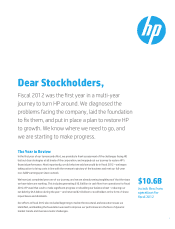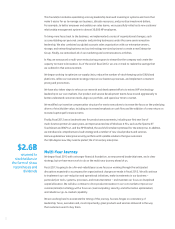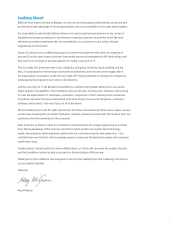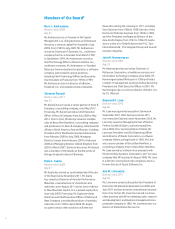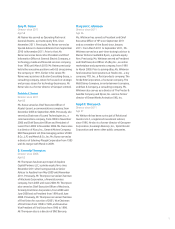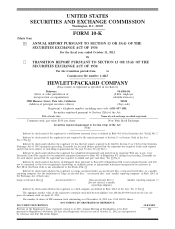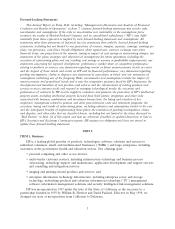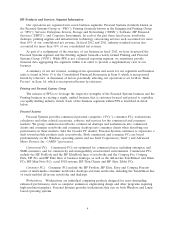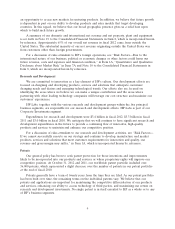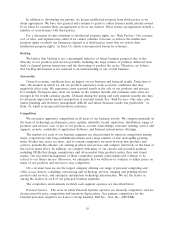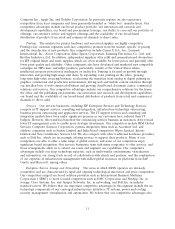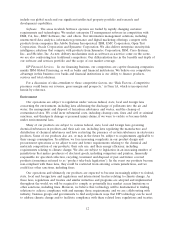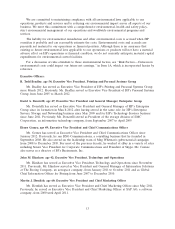HP 2012 Annual Report Download - page 12
Download and view the complete annual report
Please find page 12 of the 2012 HP annual report below. You can navigate through the pages in the report by either clicking on the pages listed below, or by using the keyword search tool below to find specific information within the annual report.HP Products and Services; Segment Information
Our operations are organized into seven business segments: Personal Systems (formerly known as
the Personal Systems Group or ‘‘PSG’’); Printing (formerly known as the Imaging and Printing Group
or ‘‘IPG’’); Services; Enterprise Servers, Storage and Networking (‘‘ESSN’’); Software; HP Financial
Services (‘‘HPFS’’); and Corporate Investments. In each of the past three fiscal years, notebooks,
desktops, printing supplies and infrastructure technology outsourcing services each accounted for more
than 10% of our consolidated net revenue. In fiscal 2012 and 2011, industry standard servers also
accounted for more than 10% of our consolidated net revenue.
As part of a realignment of the structure of our business in fiscal 2012, we have structured the
Personal Systems segment and the Printing segment beneath a newly formed Printing and Personal
Systems Group (‘‘PPS’’). While PPS is not a financial reporting segment, we sometimes provide
financial data aggregating the segments within it in order to provide a supplementary view of our
business.
A summary of our net revenue, earnings from operations and assets for our segments and business
units is found in Note 19 to the Consolidated Financial Statements in Item 8, which is incorporated
herein by reference. A discussion of factors potentially affecting our operations is set forth in ‘‘Risk
Factors’’ in Item 1A, which is incorporated herein by reference.
Printing and Personal Systems Group
The mission of PPS is to leverage the respective strengths of the Personal Systems business and the
Printing business in creating a single, unified business that is customer-focused and poised to capitalize
on rapidly shifting industry trends. Each of the business segments within PPS is described in detail
below.
Personal Systems
Personal Systems provides commercial personal computers (‘‘PCs’’), consumer PCs, workstations,
calculators and other related accessories, software and services for the commercial and consumer
markets. We group commercial notebooks, commercial desktops and workstations into commercial
clients and consumer notebooks and consumer desktops into consumer clients when describing our
performance in these markets. Like the broader PC market, Personal Systems continues to experience a
shift toward mobile products such as notebooks. Both commercial and consumer PCs are based
predominately on the Windows operating system and use Intel Corporation (‘‘Intel’’) and Advanced
Micro Devices, Inc. (‘‘AMD’’) processors.
Commercial PCs. Commercial PCs are optimized for commercial uses, including enterprise and
SMB customers, and for connectivity and manageability in networked environments. Commercial PCs
include the HP ProBook and the HP EliteBook lines of notebooks and the Compaq Pro, Compaq
Elite, HP Pro and HP Elite lines of business desktops, as well as the All-in-One TouchSmart and Omni
PCs, HP Mini-Note PCs, retail POS systems, HP Thin Clients and HP Slate Tablet PCs.
Consumer PCs. Consumer PCs include the HP Pavilion, HP Elite, Envy and Compaq Presario
series of multi-media consumer notebooks, desktops and mini notebooks, including the TouchSmart line
of touch-enabled all-in-one notebooks and desktops.
Workstations. Workstations are individual computing products designed for users demanding
enhanced performance, such as computer animation, engineering design and other programs requiring
high-resolution graphics. Personal Systems provides workstations that run on both Windows and Linux-
based operating systems.
4



